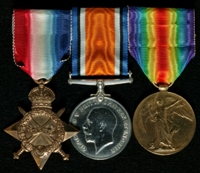

(L to R) 1914-15 Star; British War Medal; Allied Victory Medal
George was born on the 19th January 1895 in Sheffield, Yorkshire. His father was called Peter Huddleston Tyson and his mother was Amy E. C. Tyson. We believe the C may have been short for Catherine. He had an older brother called Joseph Edmund and 2 younger sisters named Amy Edith and Marion. The family were Roman Catholics.
Joseph's medals are also in the Museum of the Manchester Regiment collection.
Joseph, who was 2 years older than George, and Amy, who was 5 years younger, were both born in Oldham in Lancashire. The family seems to have settled here by 1901, when they lived at 51 Beechey Street.
In this year Peter worked as a steward at a club, most likely a private gentleman's social club, rather than the modern meaning of an entertainment venue. He was also a 'well known sprinter' in Oldham's athletics circles. George was a 'well known footballer'.
Peter died between April and June 1909, aged 43. By 1911 Amy and her children had moved a few doors to number 47. Joseph and George both worked to support their mother and sisters. They were both cotton mule piecers in one of Oldham's many cotton mills. We know Joseph worked for the Greenacres Spinning Company, but not whether George also did.
In early 1914 George joined the 10th Battalion of the Manchester Regiment. This was a unit of the Territorial Force based in Oldham. George kept his civilian home and job, and trained as a soldier during evenings and weekends. The battalion also held annual training camps, lasting around 2 weeks. George's service number was 1691.
The First World War broke out in August 1914, and the 10th Battalion was called into service. They set sail for Egypt on the 10th September, arriving in Alexandria on the 25th.They trained in Egypt until the 6th May 1915 when they took part in the invasion of Gallipoli.
We don't know whether George sailed with the battalion, although he had definitely joined them by the time they went to war in Gallipoli. Joseph enlisted in early September, with the service number 2199. He had also joined the battalion by the 6th May.
We believe George served with the renamed 1/10th Battalion for the rest of the war. They fought in Gallipoli until the theatre was evacuated in December. Both brothers 'went right through the Gallipoli struggle without a scratch'.
The battalion then returned to Egypt where they took part in the defence of the Suez Canal against a Turkish attack. This involved long patrols of the Sinai Desert, and living in primitive conditions amongst the sand dunes.
On the morning of the 21st March 1916 Joseph was killed in an unfortunate accident. George wrote a letter to their mother explaining what had happened. Joseph had been sleeping in a pit with a large number of sandbags in front of it. For some reason at around 5am they gave way and collapsed on him, 'killing him instantly'. He was 23 years old.
George held the rank of Lance Corporal when his brother died. He would eventually reach Acting Sergeant by the end of the war.
In March 1917 the 1/10th Battalion left Egypt and was sent to the Western Front. At around this time soldiers serving in units of the Territorial Force were given new service numbers. George's became 375273.
The battalion served on the old Somme battleground at Epehy and Havrincourt during the summer of 1917, before moving north to Ypres in Belgium during late August.
During the autumn of 1917 the 1/10th Battalion guarded the North Sea coast at Nieuwpoort whilst the Passchendaele Offensive was fought around Ypres. They returned to France in November and were stationed around Bethune.
During March and April 1918 George and the 1/10th Battalion helped to defeat the German Spring Offensive. The attacks began on the 21st March, while the battalion was in the rear, but they were quickly organised and by the evening of the 24th they were on the front line near the village of Ervillers.
The Germans shelled the village very heavily, and launched several attacks on the 25th. The 1/10th Battalion fought them all off before retreating from the village to continue fighting further west. They fought hard for the next 2 weeks as they tried to slow the German attack. They returned to the front on the 14th April and served there until the 6th May.
The German offensive was defeated, and on the 8th August the Allies began one of their own. This was extremely successful and drove the Germans back. It continued until the end of the war on the 11th November. We believe George served with the 1/10th Battalion until the end of the war.
After the war George was demobilised out of the Army and returned to Oldham. By the end of the 1920s he was living on Hulley Street and working as a cotton spinner.
Amy died in mid 1929, aged 60. This meant she did not live to see George get married. His wedding took place at St Stephens Parish Church in Oldham on the 25th January 1930. His wife was Emily Gibson, a cardroom hand in a mill. We don't believe they had any children.
The couple lived in Oldham for the rest of their lives. Emily was 79 when she died between October and December 1972. George died in November 1985. He was 90.
George and Joseph's medals were donated to the Museum of the Manchester Regiment together in September 1994.




